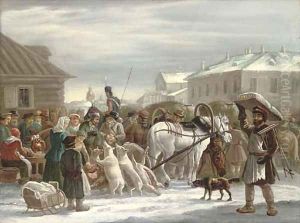Aleksander Osipovich Orlovski Paintings
Aleksander Osipovich Orlovski was a prominent Polish-Russian artist, born in 1777 in Warsaw, then part of the Polish-Lithuanian Commonwealth. He emerged as a significant figure in the transition period between the late 18th and early 19th centuries, a time of great social and political change in Europe. Orlovski's work is often characterized by its vivid portrayal of military life, as well as scenes from the everyday lives of people, especially those from the lower classes. His artistic journey began in Warsaw, but it was in Russia where he found his fame and patronage, settling in Saint Petersburg.
Orlovski's early life was marked by his enrolment at the Warsaw Drawing Class, an institution that was part of the Society for the Encouragement of Fine Arts. His talent soon caught the eye of various patrons, which allowed him to travel and further his education. This period of his life was crucial for developing his style, which would later be celebrated for its dynamic composition and keen observation of detail. By the time he moved to Russia in the early 19th century, Orlovski had already developed a distinctive style that blended elements of Romanticism with a keen sense of realism, particularly in his depiction of military subjects.
In Russia, Orlovski quickly became associated with the Imperial court and was commissioned to produce works celebrating the military successes of the Russian Empire. Despite his engagement with such grand themes, he never lost his touch for depicting the lives of ordinary people, a trait that endeared him to a wider audience. His works from this period include a variety of media, including watercolors, etchings, and sketches, reflecting the versatility of his artistic skills. Orlovski’s contributions to Russian art were significant, helping to bridge the cultural gap between Poland and Russia and introducing elements of Polish artistic tradition into Russian art.
Despite his success, Orlovski's life was not without challenges. He navigated the complexities of working under imperial patronage and the artistic demands of his time, striving to maintain his creative integrity while fulfilling commissions. He remained in Russia for the remainder of his life, passing away in 1832 in Saint Petersburg. Today, Aleksander Osipovich Orlovski is remembered as a key figure in the artistic landscape of early 19th-century Eastern Europe, celebrated for his ability to capture the spirit of his times with both accuracy and artistic flair. His legacy is preserved in numerous collections, both in Poland and Russia, where his works continue to be studied and admired.
